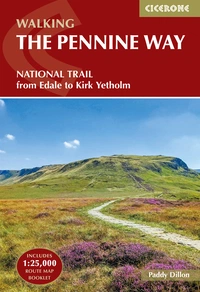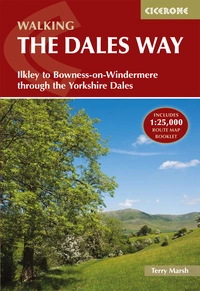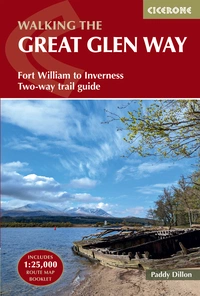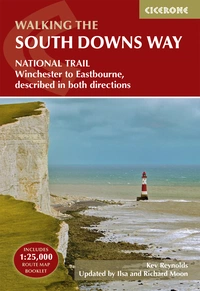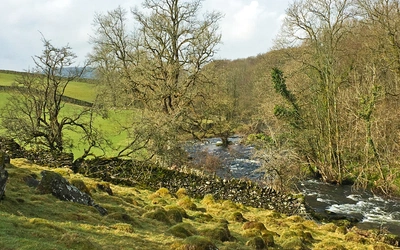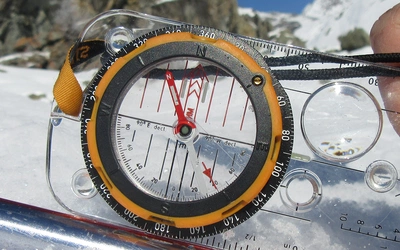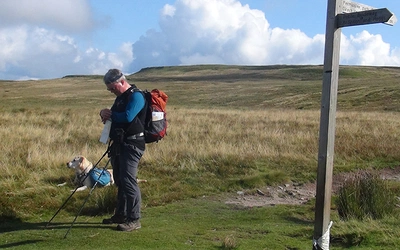Walking in winter: the best UK long-distance routes
Although it has seasonal challenges of poor weather and limited daylight, walkers can still enjoy long-distance routes in winter months. With its network of long-distance trails, the UK offers plenty of options for walking in winter. This article explores the options and will help you choose the route or challenge that is right for you in winter.
What are the challenges of walking in winter?
The first thing to talk about
is the weather. While in general the British Isles ‘enjoys’ relatively
mild winter temperatures, there can often be cold periods when the
temperatures remain at or below freezing.
Then there is the question of precipitation, which can come in the form of rain, hail, sleet or snow, and usually quite a lot of it during the winter months! The prevailing winds hitting the British Isles come from the Atlantic, so although strong, they tend to be relatively mild in temperature, but a northerly or easterly wind in winter can quickly reduce the effective temperature by at least ten degrees, a significant amount when you are starting at around freezing or below.
Daylight hours will be considerably shorter, reducing to about 8 hours in the far southwest of England, but only providing about 6 hours of daylight in Scotland. That might sound like plenty of time, but if the terrain is difficult and weather conditions are poor, you can easily find that your ‘normal’ pace is reduced by half.
There are also additional pressures; you will need to wear and carry extra clothing to keep warm and well-protected, more food to keep energy levels up, and a flask with a hot drink. This all adds additional weight to carry, possibly reducing your pace and range.
What are the advantages of walking in winter?
One of the great advantages of tackling a long-distance route in winter is that you are likely to have the route to yourself, free
to enjoy being outdoors on a journey and an adventure, with space
around you and, if you’re really lucky, good views and photography
opportunities. If
the weather is cold and frosty, there is a good change that the skies
will be clear, providing wonderful light and long shadows for truly
stunning photography opportunities.
Snow-covered peaks can contrast dramatically with the surrounding landscape, although hard ground can have mixed blessings – if it’s smooth and hard you can often find you can cover distances easily, but frozen churned-up mud is a quick way to get a sprained ankle if you’re not careful!
For some, the additional challenges of winter walking are exactly what they hope for. That extra effort, the exhilaration of overcoming difficult terrain and whatever weather has been thrown at you, then that warm, almost smug sense of achievement as you settle in safely at the end of the day. You may also hate walking in hot weather, which can slow you down in a completely different way!
How to choose your winter walking route
Whether
you are looking for the ultimate challenge or a relatively safe and achievable long-distance excursion during the winter, there are some obvious ways to steer your choice of route. Generally speaking, keeping to routes that don’t tend to go too high will minimise the risks of deep snow and any risks associated with navigation. Given limited daylight and potential slow progress, make sure that you don't pick a route where the stages are too long.
There are other issues related to terrain to consider. Paddy’s preference for tackling boggy sections of the Pennine Way in cold and frosty conditions probably rings true with many walkers, but it’s no joy walking on chalk and clay downlands in winter and watching your boots quickly grow to the size of an elephant's with all the goo stuck to them!
Walking the Pennine Way
NATIONAL TRAIL - From Edale to Kirk Yetholm
£17.95
Guidebook to the Pennine Way National Trail with OS map booklet. The 265 mile route from Edale to Kirk Yetholm takes three weeks to walk and is suitable for fit and experienced long-distance walkers. The route crosses the Peak District, Yorkshire Dales and North Pennines National Parks. Includes separate OS 1:25,000 map booklet of the route.
More informationAccommodation
Accommodation in some areas may be a little more limited, but it should still be perfectly possible to find somewhere to stay, even if some of your stages need adjusting accordingly – a long day followed by a shorter day, perhaps. When I walked the South Downs Way in winter, with just one exception I was able to find somewhere to stay each night that allowed for sensible stages.
There are also some routes such as the Thames Path that not only have a reasonable chance of accommodation, but good public transport links too. This makes it easy to leapfrog stages, combine two-night stays, or even to walk entirely in single-day stages if you live nearby.
Be wary of planning on camping overnight. Scottish bothys can provide spartan but much-needed shelter. In all these cases you will need to be prepared to carry considerably more gear with you.
What are the best long-distance routes to consider walking in winter?
Scotland
In Scotland, the only really realistic choice is the Great Glen Way.
With few exceptions the walking surface is good, it tends to keep free
from snow. Buses run throughout the year, allowing for options
to stay in just one or two places and carry only what you need for
during the day. The West Highland Way
might be possible however, this route could be incredibly
challenging if there are strong northerly winds or snow funnelling
through the valleys!
England
In northern England, the Dales Way is a delight at any time of year, never going too high (although the crossing over to Ribblehead can be very bleak and exposed). The Cumbria Way might also be suitable. There are only a
couple of sections where the route climbs up into the higher fells (over
Stake Pass and High Pike), and there is an option through the
fells north of Keswick to avoid summiting High Pike.
There again, if you want the challenge of the Pennine Way,
and are sufficiently experienced to deal with the conditions, then try
to pick a cold, frosty but not windy period, and you might just have a
fantastic trip. If you’re a runner, then of course there’s always the
Spine Race that takes place in the depths of winter!
Southern England has a fine network of national trails. However, many are on chalk or clay downlands, which when wet and muddy can become a complete nightmare to walk on. That rules out the Cotswold Way and a number of others, but if you want to walk in that general area, then the Kennet and Avon Canal walk should be suitable for a gentle winter trek. Paddy Dillon suggests the Thames Path, and recommends the Ridgeway and the South Downs Way, especially if the weather is cold and frosty.
Walking the Dales Way
Ilkley to Bowness-on-Windermere through the Yorkshire Dales
£16.95
Guidebook to walking the Dales Way. This picturesque 79 mile route through the Yorkshire Dales between Ilkley and Bowness-on-Windermere is one of the most gentle long-distance walks in Britain. The route is described in both directions, passing through Wharfedale, Dentdale and the eastern fringe of the Lake District. With 1:25K OS map booklet.
More informationWales
The coast of Wales can offer various experiences for the winter walker. In the north, the Wales Coast Path
follows a low-lying, but less scenic route on good surfaces. There are better options for scenery around Anglesea, the Llyn Peninsula
and Ceredigion coast, and also on the Pembrokeshire Coast Path,
all of which should have a reasonable level of accommodation open. In
windy and wet weather, coastal paths can be pretty nasty, so choosing
the direction of travel is something to consider.
The Pembrokeshire Coast Path
NATIONAL TRAIL - Amroth to St Dogmaels
£17.95
This guidebook describes the Pembrokeshire Coast Path National Trail. The scenic long-distance walk from Amroth to St Dogmaels is 180 miles long and takes about 2 weeks to walk, with soaring rugged cliffs, tranquil inlets and broad sandy beaches. Includes planning schedules, accommodation guidance and a 1:25,000 OS map booklet.
More information| Long-distance trail | Miles | Features |
|---|---|---|
| Great Glen Way | 79 | Low-lying, public transport options |
| West Highland Way | 95 | Good surface, some remote and exposed stages |
| Dales Way | 79 | Mainly low level, can be muddy, scenic |
| Cumbria Way | 73 | Scenic, fairly low, mainly good surfaces |
| Pennine Bridleway | 90 | Dales section, classic limestone scenery |
| Wales Coast Path | Up to 870 | Choose either scenic, or low-lying! |
| Pembrokeshire Coast Path | 180 | Scenic, can be exposed, accommodation likely |
| Thames Path | 180 | Can be walked in stages, good transport |
| South Downs Way | 100 | Good views, accommodation likely, muddy |
| South West Coast Path | Up to 630 | Check accommodation, high cliffs, storms |
| Kennet and Avon Canal | 94 | Flat, easy walking, generally good surfaces |
Comments and suggestions from enthusiasts...
Thanks to Mike Barrie for this suggestion:
The North Norfolk Coast Path is a great walk in winter, accommodation, transport, etc., more than adequate (though hostels may be closed this winter). At 45 miles an easy 4 days to fit in with daylight hours and winter bus timetable. If that’s too short, turn at Cromer and walk it in reverse - though, psychologically, facing the long shingle beach at Sheringham for a second time would be a challenge.


